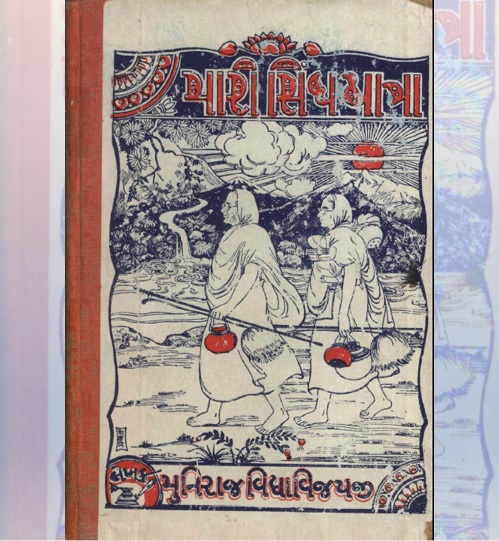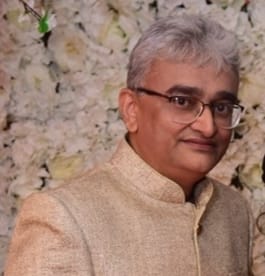
Despite the people of this region being uncivilized, they are spared from the lies, fraud, and treachery of the urban people
[Editor’s Note: This is Part 10 (Marwad and Entering Sindh) of a series of articles based on a pre-partition book named “મારી સિંધ યાત્રા” (“منهنجي سنڌ جو سفر”) in Gujarati authored by Jain sadhu Shri Vidyavijayji, narrating his experiences of travel and stay in Karachi for about 2 and a half years between 1937 and 1939. It would be advisable to click on Introductory Article and read it for a better understanding of the series. – Nasir Aijaz, Editor Sindh Courier]
Vimal Shah, Mumbai
Innocent Lifestyle
Despite the people of this region being uncivilized, they are spared from the lies, fraud, and treachery of the urban people. If you ask anything to anyone, if it is worth disclosing, he will always speak the truth. On the way I asked a shepherd in a Jungle ‘Do you eat meat?’ He said ‘Yes’. I gave him sermons and he instantly gave up non-vegetarian food. A person belonging to the finest community, if asked will clearly accept that he eats meat and drinks. Then how much ever you persuade them, they will not give up if they are not convinced, and if they give up there would be seldom someone who would break the pledge.
This is the peculiarity of people whom we call uncivilized. Whereas how are the urban people – highly educated, big businessmen, carefully listening to the discourses of sadhus – are living their life? How much do they honor their pledges? How much do they respect the sermons? Is there a need to elaborate?
One Experience
As we marched towards Sindh, we were getting varied experiences. Sometimes we are feared of certain things, but they are not that dreadful. ‘People of Sindh are very dreadful, particularly Musalman Sindhis of North and East Sindh.’ We had heard this, many times. We were going from Baytu to Sandhadhora. There were so many sand mounds one after the other that the railway tracks also must frequently turn from South to West and vice versa. The chest would not desist from pounding heavily while passing through the tracks between the mountains. What if someone will come and attack with an axe? While thinking of all these, one Musalman covered with full black attire from head to toe, donning a rifle on the shoulder, accompanied by a lady was approaching us. It did not take time to conclude that he is a Sindhi Musalman. I became a little nervous when he came close, and his figure was clearly visible. I was alone, what could he get from me apart from a few clothes? I thought of beginning a conversation with him. I enquired ‘Are you a Musalman?’ he said ‘Yes’. I asked, ‘Do you eat Gosht?’ answer was ‘Yes’. I asked, ‘Is eating Gosht considered jayaz in Quran-e-Sharif?’ He said ‘No’.
I observed that he was very happy to hear the mention of the Quran-e-Sharif. After that, we had an interesting conversation for about half an hour, and he and his wife pledged in the name of Khuda to give up meat and fish.
We had hundreds of such experiences during our journey, but it is not possible to narrate all of them here.
Station Masters
The borders of Malani Pargana are 1.5 miles away from the Munabao station. That’s where the jurisdiction of the Marwad ends and the jurisdiction of the Sindh Government starts. Soldiers from both sides are deployed at the Khokhrapar station. Of course, the Jodhpur railway line is extended right up to the Mirani station near Hyderabad.
All the station masters up to here were very kind and devoted. Almost all of them belonged to the Jodhpur State or Gujarati or U.P. residents at a few places. They found our journey to Sindh very astonishing. Some of them even insisted we stay for more than a day and give them the opportunity to serve us.
Entry into Sindh
Marwad and Sindh share a common border. Every region has its own special features. Marwad and Sindh both possess special features of their own.
Āṅkaḍē kī jhōmpaḍī, aura phōgana ka sāga,
bajarē kī rōṭī, aura mōṭhana kī dāla,
dēkhī rājā mānasiṅga tērī māravāḍa.
Response to the above:
Sindha gindha pūjā jinda pīra kī,
gadhē kī savārī karē, cāla calē amīra kī.
Mōcaḍōṁ kī māra paḍē, jaba śud’dha na rahē śarīra kī,
dēkhī tērī sindha gindha pūjā jinda pīra kī.
These are the arguments of some Sindhi and Marwadi at the times of the Maharaja Mansinh of Jodhpur. Both have presented the special features of each other’s regions.
Despite being meat-fish-eating people, they have stunning faith towards ‘Sain’. The people of this region address Sadhu-Sant as ‘Sain’.
As stated earlier, there is a population of about 75% Musalman, 23% Hindu, and 2% Christians – Parsi – etc. communities in Sindh. The Musalmans mostly don black clothes from head to toe with an axe in their hands. Abundant clay and dust turn even white clothes into the black in no time. Water has been distributed in the whole region using canals, so the clay has turned sticky. All the farming lands are flooded with water, so there are plenty of mosquitoes and gnats. Whether Hindu or Musalman, everyone eats meat and fish, so there’s hardly any difference between them apart from their names. If you visit the home of a Lohana Bhatia, a Soni, a Suthar, or a Lohar, anywhere you go – they will smell meat and fish all the time. As soon as you enter a village, you may encounter a person identified as a Hindu by his attire, carrying mutton or fish. As a result, people like us cannot take shelter in anyone’s home.
Faith towards ‘Sain’
Despite being meat-fish-eating people, they have stunning faith towards ‘Sain’. The people of this region address Sadhu-Sant as ‘Sain’. If the news of any ‘Sain’ coming and halting at a particular place in the village spreads, the leaders of different communities and other people would gather. Everyone would bow down to the Sain with respect and offer sweets and delicacies either individually or Panchayati (together as a community). People of Sindh are still carrying the faith that ‘रिक्तपाणिर्न पस्येञ्च राजानं दैवतं गुरुम्’ – ‘you should not pay a visit to a King, God or Guru empty-handed.’ They are straightforward by heart. Despite being non-vegetarian for generations, once they get the true knowledge and get convinced by the preaching they give up in no time. Most of the people do not even touch them once given up, while a few break their pledge under unfavorable circumstances.”
Some people request us to accept alms from their home and if we tell them that ‘we cannot accept alms from your home because you are non-vegetarian’, they get prepared to give up meat and fish for a lifetime. The Hindus who give up non-vegetarian food believe they have become ‘Vishnu’. If someone tells you that ‘I have become Vishnu for a long time’ he means he has given up non-vegetarian food for a long time.” (Continues)
Click here for Part-I, Part-II, Part-III, Part-IV, Part-V , Part-VI , Part-VII , Part-VIII , Part-IX
__________________
About the contributor of the series of Articles based on the book
 Vimal Shah is a follower of Jainism by birth and is based in Mumbai, India. He is a Computer Engineer and holds a Diploma in Jainology from Mumbai University. He has immense interest in reading, writing, studying, and teaching Jain Philosophical subjects. He conducts classroom as well as on-line sessions on Jain Philosophical courses. He has created several power point presentations with animation which he uses while teaching and has participated in several Jain Community events to present and explain the relevant subjects to the visiting audience. He has significantly contributed to the translation, reviewing, and editing of the set of books ‘Compendium of Jainism’ of JAINA, USA from English to Gujarati – an initiative of the JAINA India Foundation. He is also associated with a Project for the translation of Jain Aagams (Scriptures) from Gujarati to English and continues to study various subjects and remains a student of Jain Philosophy. He has a special interest in the history and preservation of the Jain Heritage in Pakistan, and is associated with the Jain Heritage Foundation, New Delhi.
Vimal Shah is a follower of Jainism by birth and is based in Mumbai, India. He is a Computer Engineer and holds a Diploma in Jainology from Mumbai University. He has immense interest in reading, writing, studying, and teaching Jain Philosophical subjects. He conducts classroom as well as on-line sessions on Jain Philosophical courses. He has created several power point presentations with animation which he uses while teaching and has participated in several Jain Community events to present and explain the relevant subjects to the visiting audience. He has significantly contributed to the translation, reviewing, and editing of the set of books ‘Compendium of Jainism’ of JAINA, USA from English to Gujarati – an initiative of the JAINA India Foundation. He is also associated with a Project for the translation of Jain Aagams (Scriptures) from Gujarati to English and continues to study various subjects and remains a student of Jain Philosophy. He has a special interest in the history and preservation of the Jain Heritage in Pakistan, and is associated with the Jain Heritage Foundation, New Delhi.